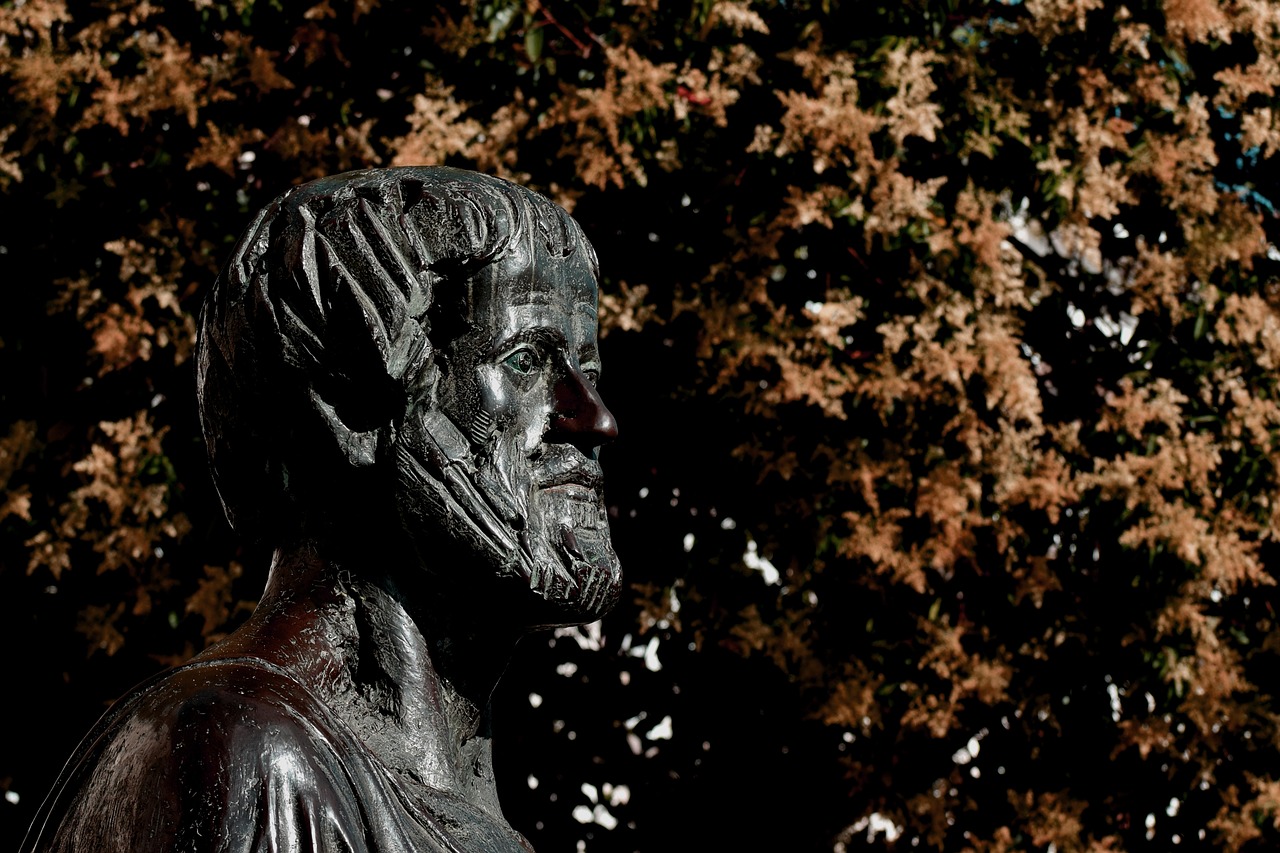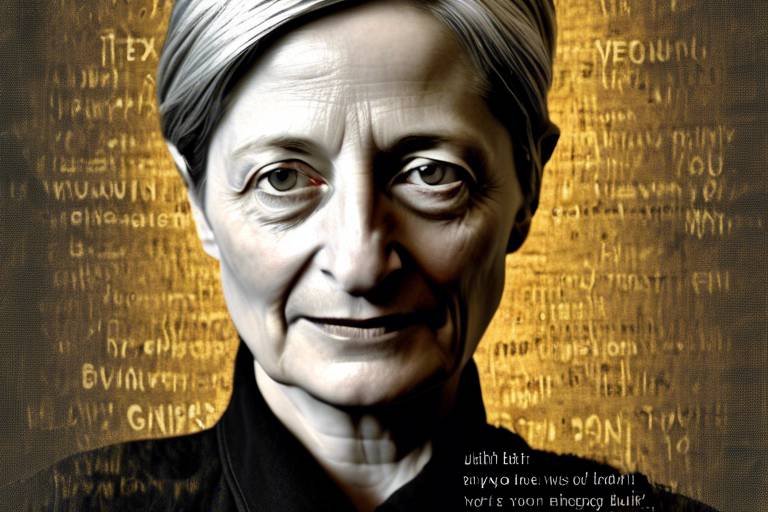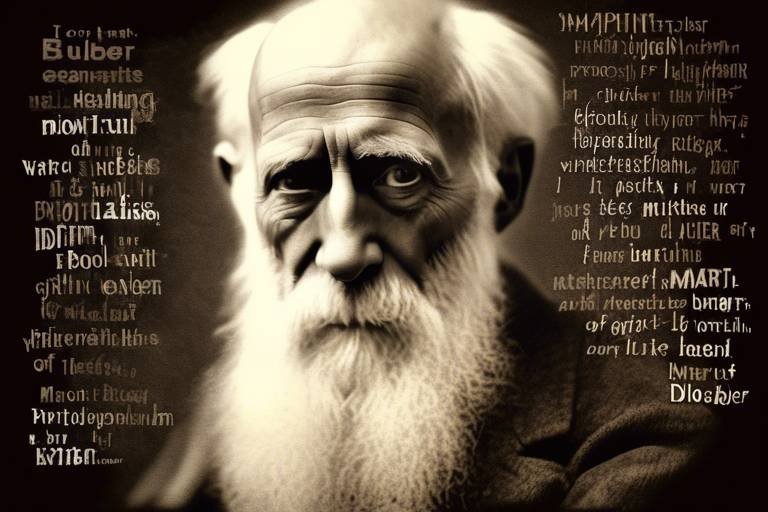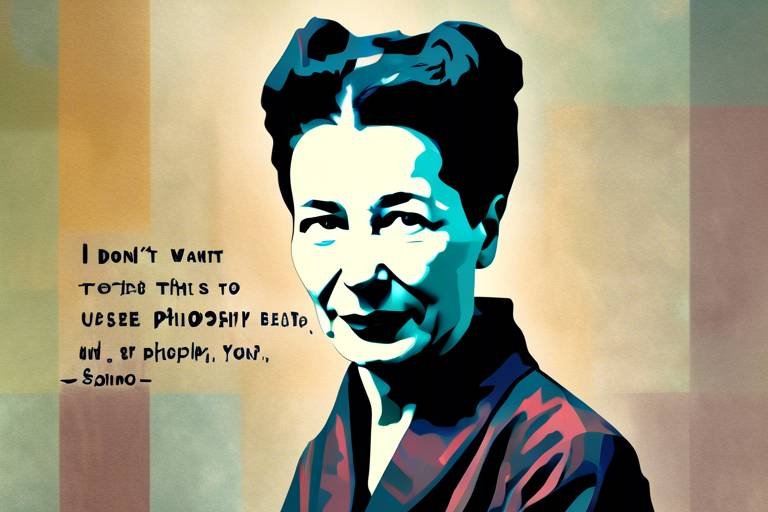The Complete Guide to Philosophical Realism
Welcome to an enlightening journey through the fascinating world of philosophical realism! This article aims to unravel the fundamental concepts that underlie this intriguing philosophical perspective, providing you with a comprehensive understanding of its historical development, key figures, and various interpretations. Whether you're a seasoned philosopher or just dipping your toes into the vast sea of philosophy, this guide will equip you with the insights you need to grasp the essence of realism. So, buckle up as we explore how philosophical realism posits that reality exists independently of our perceptions, and how this belief sets it apart from other philosophical viewpoints like idealism and constructivism.
At its core, philosophical realism is a belief that the world exists outside of our minds and perceptions. Imagine walking through a forest. The trees, the sky, and the sounds of nature exist, whether or not you are there to witness them. This is the essence of realism: the idea that the universe is not merely a figment of our imagination but a tangible reality that operates independently of our thoughts and beliefs. This section will delve into the core principles of realism, highlighting how they create a stark contrast with other philosophical schools of thought.
For instance, idealism posits that reality is mentally constructed or immaterial, while constructivism suggests that our understanding of the world is shaped by social processes and interactions. In contrast, realism champions the idea that there are objective truths about the world that can be discovered through observation and reason. This fundamental belief opens the door to various interpretations and applications across different fields, including science, ethics, and metaphysics.
The roots of philosophical realism can be traced back to ancient philosophy, where thinkers like Plato and Aristotle laid the groundwork for what would evolve into a robust philosophical tradition. During the Renaissance, realism experienced a resurgence as scholars began to challenge the dominant idealist perspectives of the Middle Ages. This period marked a significant shift in thought, as the emphasis on empirical observation and human experience gained traction.
Fast forward to the modern era, and we see realism influencing contemporary philosophical discourse. The evolution of realism is not merely a linear progression; it is a rich tapestry of ideas and debates that continue to shape our understanding of reality today. Key historical figures and movements have played pivotal roles in this development, and we will explore their contributions in detail.
Throughout history, several influential philosophers have shaped the discourse on realism. Among these luminaries are Aristotle, René Descartes, and contemporary thinkers like Hilary Putnam and Saul Kripke. Each of these philosophers has offered unique insights into the nature of reality, contributing to the rich dialogue surrounding realism. Their varying interpretations reflect the diversity of thought within the realist tradition.
Aristotle, often regarded as the father of realism, laid the groundwork for realist thought with his ideas on substance and essence. He argued that objects in the world possess an inherent nature that is independent of our perceptions. For Aristotle, understanding the essence of a thing was crucial to grasping its existence. This foundational perspective has had a lasting impact on the development of philosophical realism, influencing generations of thinkers.
In the contemporary landscape, philosophers like Hilary Putnam and Saul Kripke have advanced realism in new and exciting directions. Putnam's work challenges the notion of a single, objective reality, suggesting instead that our understanding of the world is multifaceted and influenced by various factors. Similarly, Kripke's theories on reference and necessity provide a fresh lens through which to examine the complexities of existence and truth. Their contributions demonstrate that realism is not a static doctrine but a dynamic field that continues to evolve in response to new challenges and ideas.
The debate between realism and anti-realism is one of the most significant in contemporary philosophy. While realism asserts that there is an objective reality that exists independently of our thoughts, anti-realism challenges this notion, suggesting that our understanding of truth and existence is shaped by human experience and social constructs. This section will explore the implications of these differing viewpoints on philosophy and science, highlighting the vibrant discussions that emerge from this intellectual clash.
Philosophical realism encompasses various branches, each with its own nuances and applications. Key types include metaphysical realism, epistemological realism, and scientific realism. Understanding these categories is essential for grasping the broader implications of realism in different fields of inquiry.
Metaphysical realism posits that the world exists independently of our thoughts and perceptions. This belief has profound implications for our understanding of existence and the nature of objects in the universe. It raises questions about how we can know things about the world and what it means for something to exist. This section will delve deeper into the philosophical ramifications of this stance.
Scientific realism argues that scientific theories provide an accurate description of the world. This perspective has significant implications for scientific practice, theory validation, and our understanding of the universe. By examining the philosophical underpinnings of scientific realism, we can better appreciate its role in shaping our comprehension of reality.
- What is philosophical realism? Philosophical realism posits that reality exists independently of our perceptions and beliefs.
- Who are the key figures in realism? Key figures include Aristotle, René Descartes, Hilary Putnam, and Saul Kripke.
- What are the different types of realism? The main types include metaphysical realism, epistemological realism, and scientific realism.
- How does realism differ from anti-realism? Realism asserts the existence of an objective reality, while anti-realism suggests that our understanding of truth is shaped by human experience.

Understanding Philosophical Realism
Philosophical realism is a fascinating concept that posits that reality exists independently of our perceptions. Imagine walking through a bustling market; the vibrant colors, the aroma of spices, and the sounds of chatter all contribute to your experience. But what if, when you leave, the market ceases to exist simply because you are no longer there? Philosophical realism argues against this idea, suggesting instead that the market—and indeed, the entire universe—exists regardless of whether we perceive it or not. This fundamental belief sets realism apart from other philosophical viewpoints, such as idealism and constructivism, which posit that reality is shaped by our perceptions and experiences.
At its core, realism asserts that the world is made up of objects and entities that have an existence independent of our thoughts or beliefs about them. It emphasizes the importance of the external world and asserts that our understanding of it is not merely a product of our minds. This leads to a deeper inquiry into the nature of truth, knowledge, and existence itself. For instance, when we discuss a tree in the forest, realism holds that the tree exists whether or not anyone is there to observe it. This perspective is crucial in various fields, including science, where the existence of phenomena is often contingent upon empirical evidence rather than subjective interpretation.
To further elucidate the distinctions among different philosophical perspectives, let’s consider a few key contrasts:
- Realism: Asserts the independent existence of reality.
- Idealism: Suggests that reality is mentally constructed or immaterial.
- Constructivism: Proposes that knowledge is constructed through social processes and interactions.
These distinctions are not merely academic; they have profound implications for how we understand the world around us. For instance, in scientific inquiry, a realist perspective encourages the pursuit of objective truths about the universe, while an idealist viewpoint might lead to a more subjective interpretation of scientific findings. Philosophical realism thus serves as a crucial foundation for many disciplines, advocating for an understanding of reality that transcends individual perception.
Furthermore, realism invites us to consider the nature of our knowledge. How do we come to know things about the world? Realists argue that our knowledge is grounded in the existence of the objects we study, which exist independently of our thoughts. This leads to important questions about the nature of truth and how we can ascertain it. Is truth a reflection of reality, or is it shaped by our perceptions? These questions form the crux of ongoing debates within philosophy, making the exploration of realism not only relevant but essential.
In summary, understanding philosophical realism requires grappling with the idea that reality exists beyond our perceptions. It challenges us to consider the implications of this belief in various fields of inquiry, from philosophy to science. By recognizing the independent existence of objects and entities, we can better appreciate the complexities of truth, knowledge, and existence itself.

Historical Development
Philosophical realism has a rich and intricate history that stretches back to ancient times, evolving through various cultural and intellectual movements. Its roots can be traced to the thoughts of early philosophers who grappled with the nature of reality and existence. For instance, the ancient Greeks, particularly Plato and Aristotle, laid the groundwork for realist thought. While Plato’s idealism posited that true reality was found in abstract forms, Aristotle countered this by asserting that reality is grounded in the tangible world around us. This fundamental debate between idealism and realism set the stage for centuries of philosophical inquiry.
As we move into the Renaissance, a period marked by a revival of classical thought, realism began to resurface with renewed vigor. Thinkers such as Francis Bacon and Galileo Galilei emphasized observation and empirical evidence, which were pivotal in the development of modern scientific methods. Their insistence on the objective nature of reality challenged the prevailing scholastic traditions that often prioritized abstract reasoning over empirical investigation. This shift not only influenced the scientific community but also had profound implications for philosophical realism.
The Enlightenment further propelled the discourse on realism, with philosophers like John Locke and David Hume contributing significantly to the understanding of knowledge and perception. Locke’s theory of tabula rasa posited that the mind is a blank slate shaped by experience, reinforcing the idea that our understanding of reality is mediated through our sensory experiences. Hume, on the other hand, questioned the certainty of knowledge, arguing that our perceptions can never fully encapsulate the nature of the external world. This tension between perception and reality continued to fuel debates among philosophers, leading to a more nuanced understanding of realism.
In the 19th and 20th centuries, realism experienced a resurgence in various forms, particularly in response to the rise of idealism and anti-realist philosophies. The emergence of logical positivism and scientific realism marked a significant turning point. Philosophers like Bertrand Russell and Ludwig Wittgenstein sought to ground philosophical inquiry in the language of science, advocating for a realist interpretation of scientific theories as reflections of an objective reality. This period also saw the rise of pragmatism, with thinkers like William James and John Dewey emphasizing the practical implications of philosophical ideas, further enriching the discourse on realism.
Today, philosophical realism continues to evolve, integrating insights from various disciplines, including science, psychology, and linguistics. The debates surrounding realism are as vibrant as ever, with contemporary philosophers like Hilary Putnam and Saul Kripke challenging traditional notions and offering new perspectives. Their work illustrates the dynamic nature of realism, demonstrating how it adapts to address contemporary issues while remaining grounded in its historical roots.
As we reflect on the historical development of philosophical realism, it becomes clear that this perspective is not merely a static set of beliefs but a living tradition that responds to the changing landscape of human thought. Its journey through time showcases the complexity and depth of our quest to understand reality, inviting us to engage with the ongoing dialogue about what it means to exist in a world that often defies simple explanations.
- What is philosophical realism? Philosophical realism is the view that reality exists independently of our perceptions or beliefs. It asserts that the world is as it is, regardless of how we perceive it.
- How did philosophical realism develop historically? Realism has evolved from ancient philosophy through the Renaissance and Enlightenment, responding to various intellectual movements and challenges throughout history.
- Who are some key figures in the history of realism? Key figures include Aristotle, John Locke, and contemporary philosophers like Hilary Putnam and Saul Kripke, each contributing to the discourse in unique ways.
- What is the difference between realism and anti-realism? Realism asserts that there is an objective reality, while anti-realism challenges this notion, often arguing that our understanding of reality is shaped by our experiences and perceptions.

Key Figures in Realism
Philosophical realism has been shaped and enriched by the contributions of several key figures throughout history. These thinkers have not only defined the principles of realism but have also engaged in vigorous debates that have pushed the boundaries of philosophical inquiry. Let's take a closer look at some of the most influential philosophers who have made significant impacts on the discourse surrounding realism.
First and foremost, we cannot discuss realism without mentioning Aristotle. Often regarded as the father of Western philosophy, Aristotle's work laid the groundwork for realist thought. He introduced the concept of substance and essence, arguing that objects exist independently of our perception. His assertion that "to be is to be something" encapsulates the essence of metaphysical realism. Aristotle's influence extends beyond his time, as his ideas continue to resonate with modern philosophical discussions.
Moving forward in time, we encounter René Descartes, a pivotal figure in the development of modern philosophy. Descartes is best known for his methodological skepticism, famously declaring, "I think, therefore I am." While his approach initially seems to lean towards idealism, his insistence on the existence of a material world laid the groundwork for a realist interpretation of knowledge. Descartes' dualism, which separates mind and body, introduces a complex layer to the discussion of realism, especially regarding how we perceive reality.
Fast forward to the 20th century, and we find contemporary philosophers like Hilary Putnam and Saul Kripke taking up the mantle of realism. Putnam is particularly known for his argument against the notion of a "God's-eye view" of reality, suggesting instead that our understanding of the world is inherently tied to our experiences and language. His concept of "internal realism" posits that while there is an objective reality, our grasp of it is mediated by our cognitive frameworks.
Similarly, Kripke's work on naming and necessity has profound implications for realism. He challenged traditional views on reference and meaning, arguing that names refer to objects in the world, thus reinforcing the realist position that there is a reality independent of our thoughts. Both Putnam and Kripke have offered new directions for realism, responding to the challenges posed by anti-realist positions and enriching the philosophical landscape.
In summary, the discourse on philosophical realism has been significantly shaped by these key figures. Each has contributed unique perspectives that have influenced how we understand the nature of reality, knowledge, and existence. Their debates and ideas continue to inspire new generations of philosophers, ensuring that realism remains a vibrant and relevant field of inquiry.
Q1: What is philosophical realism?
A1: Philosophical realism is the view that reality exists independently of our perceptions or beliefs. It asserts that the world is as it is, regardless of how we interpret or understand it.
Q2: Who are some key figures in philosophical realism?
A2: Important figures include Aristotle, René Descartes, Hilary Putnam, and Saul Kripke, each contributing significantly to the development and understanding of realism.
Q3: How does realism differ from idealism?
A3: Realism posits that objects exist independently of our thoughts, whereas idealism suggests that reality is mentally constructed or immaterial.
Q4: What are the implications of scientific realism?
A4: Scientific realism argues that scientific theories provide a true or approximately true description of the world, which has significant implications for how we validate scientific knowledge and understand the nature of reality.

Aristotle's Influence
When we think about the foundations of philosophical realism, we cannot overlook the profound impact of Aristotle. His work laid the groundwork for many philosophical discussions that followed, and his ideas continue to resonate today. Aristotle's concept of substance is particularly pivotal; he argued that substances are the fundamental realities that exist independently of our perceptions. This notion challenges the idea that reality is merely a construct of our thoughts or beliefs, a central tenet of idealism.
Aristotle believed that every substance has an essence, which defines what it is. This essence is not just a label but the core of its being. For instance, when we think about a tree, its essence encompasses its characteristics—such as being a living organism, having leaves, and growing. This idea of essence is crucial because it leads to the understanding that reality is structured and that there are objective truths that can be discovered through observation and reason.
Furthermore, Aristotle’s emphasis on empirical observation as a means to gain knowledge is another cornerstone of realism. He posited that our senses provide us with information about the world, which we can then analyze to understand the underlying principles of reality. This approach stands in stark contrast to anti-realist perspectives that might argue that our perceptions are deceptive or that reality is entirely subjective. Aristotle's insistence on the importance of the material world laid the foundation for later philosophers to explore the nature of existence and knowledge.
To illustrate the impact of Aristotle's ideas, consider the following key contributions:
| Concept | Description |
|---|---|
| Substance | The fundamental entities that exist independently of our perceptions. |
| Essence | The intrinsic nature or indispensable quality of something that determines its character. |
| Empiricism | The theory that all knowledge is based on experience derived from the senses. |
In summary, Aristotle's influence on philosophical realism cannot be overstated. His exploration of substance, essence, and the role of empirical observation has shaped the way we understand reality. By establishing that there are objective truths that exist independently of our thoughts, Aristotle paved the way for future philosophers to engage in the rich discourse surrounding realism. His ideas serve as a reminder that while our perceptions may vary, the underlying reality remains constant and can be understood through careful study and reflection.
- What is philosophical realism? Philosophical realism is the view that reality exists independently of our perceptions or beliefs.
- How did Aristotle contribute to realism? Aristotle emphasized the importance of substance and essence, arguing that these concepts are foundational to understanding reality.
- What is the difference between realism and idealism? Realism posits that reality exists independently, while idealism suggests that reality is mentally constructed.
- Are there different types of realism? Yes, there are several types, including metaphysical realism, epistemological realism, and scientific realism, each with its own focus.

Modern Realist Philosophers
In the landscape of contemporary philosophy, have emerged as pivotal figures, challenging and reshaping the discourse surrounding realism. Among them, Hilary Putnam and Saul Kripke stand out as key players who have taken traditional realist ideas and infused them with new life, responding to the complexities of the modern world. Their work not only defends realism but also adapts it to address the challenges posed by various anti-realist positions.
Hilary Putnam, for instance, is renowned for his argument against the notion that our understanding of the world is merely a reflection of our perceptions. He famously introduced the concept of semantic externalism, which posits that the meanings of our words are not solely determined by our mental states but also by the external world. This idea has significant implications for realism, as it suggests that our language and thoughts are deeply intertwined with the reality we inhabit. Putnam's work encourages us to reconsider the relationship between language and the world, emphasizing that our understanding of reality is not just subjective but is also shaped by the objective world around us.
On the other hand, Saul Kripke has made profound contributions to the philosophy of language and metaphysics that bolster realist thought. His introduction of the concept of rigid designators revolutionized the way we think about reference and meaning. Kripke argued that certain terms refer to the same objects in all possible worlds, thereby asserting a form of realism about existence that transcends mere linguistic constructs. This notion challenges the anti-realist perspective that suggests our understanding of existence is contingent on our descriptions or theories. By asserting that some truths about objects are necessary and not merely contingent, Kripke reinforces the realist position that there is a reality independent of our perceptions.
Both Putnam and Kripke illustrate the dynamic nature of realism in contemporary philosophy. They navigate the intricate relationship between language, thought, and reality, demonstrating that realism is not a static doctrine but a vibrant field of inquiry. Their contributions compel us to engage with the fundamental questions of existence and knowledge, urging us to consider how our understanding of reality is shaped by both our linguistic frameworks and the world itself.
As we explore the contributions of these modern philosophers, it becomes evident that realism continues to evolve, adapting to new challenges and insights. The ongoing debates between realism and anti-realism not only enrich philosophical discourse but also have profound implications for various fields, including science, ethics, and metaphysics. This dialogue invites us to reflect on our own beliefs about reality and the nature of existence, making the study of modern realism an essential pursuit for anyone interested in the deeper questions of life.
- What is philosophical realism? Philosophical realism is the view that reality exists independently of our perceptions and beliefs.
- Who are some key modern realist philosophers? Notable modern realist philosophers include Hilary Putnam and Saul Kripke.
- What is semantic externalism? Semantic externalism is the idea that the meanings of our words are influenced by the external world, not just our mental states.
- What are rigid designators? Rigid designators are terms that refer to the same object in all possible worlds, asserting a form of necessary existence.
- How does realism differ from anti-realism? Realism asserts that reality exists independently, while anti-realism suggests that our understanding of reality is contingent on our perceptions or theories.

Realism vs. Anti-Realism
When we dive into the philosophical waters of realism and anti-realism, it's like stepping into a vibrant debate that has captivated thinkers for centuries. At its core, realism asserts that the world exists independently of our thoughts and perceptions. This means that objects, facts, and truths are out there, waiting to be discovered, regardless of whether we are aware of them or not. On the flip side, anti-realism challenges this notion by suggesting that our understanding of reality is heavily influenced—if not entirely constructed—by our perceptions, beliefs, and cultural contexts. So, which side holds the key to understanding our world?
To better grasp the nuances between these two perspectives, let’s break down some of the critical differences:
| Aspect | Realism | Anti-Realism |
|---|---|---|
| Existence of Reality | Reality exists independently of our thoughts. | Reality is shaped by our perceptions and beliefs. |
| Nature of Truth | Truth is objective and discoverable. | Truth is subjective and context-dependent. |
| Scientific Implications | Scientific theories aim to describe an objective reality. | Scientific theories are tools for understanding our experiences. |
This contrast leads to profound implications for fields such as science, ethics, and metaphysics. For instance, in science, a realist might argue that theories like gravity or evolution describe actual phenomena in the world, while an anti-realist could assert that these theories are merely useful fictions that help us navigate our experiences.
Moreover, the debate extends into everyday life. Consider how we perceive truth in our interactions. A realist might say, "The sky is blue," and mean it as an objective fact. An anti-realist, however, might argue, "The sky appears blue to me," emphasizing that perception plays a crucial role in interpreting reality. This brings us to a fascinating question: Can we ever truly know the world as it is, or are we forever confined to our subjective experiences?
As we explore this philosophical landscape, we encounter pivotal arguments from both sides. Realists often emphasize the success of science and the consistency of scientific laws as evidence of an objective reality. In contrast, anti-realists might highlight the historical changes in scientific theories, suggesting that what we accept as "truth" is merely a reflection of current understanding rather than an absolute.
Ultimately, the realism vs. anti-realism debate is not just an academic exercise; it resonates deeply with how we interpret our experiences, engage with science, and understand the world around us. As we continue to ponder these questions, we invite you to reflect on your own beliefs. Are you leaning more towards the realist perspective, convinced of an objective reality, or do you find yourself swayed by the anti-realist view, recognizing the powerful influence of perception? The conversation is ongoing, and each perspective offers valuable insights into our quest for knowledge.
- What is the main difference between realism and anti-realism?
Realism posits that reality exists independently of our thoughts, while anti-realism suggests that our understanding of reality is shaped by our perceptions and beliefs. - How does this debate impact scientific inquiry?
Realists argue that scientific theories describe an objective reality, whereas anti-realists contend that these theories are tools for understanding subjective experiences. - Can one be both a realist and an anti-realist?
Some philosophers adopt a pragmatic approach, recognizing valid points in both perspectives depending on the context.

Types of Realism
Philosophical realism is not a monolithic concept; rather, it encompasses a variety of interpretations and applications across different domains. Each type of realism presents a unique perspective on how we understand the world and our place within it. To grasp the full scope of philosophical realism, it's essential to explore its various types, including metaphysical realism, epistemological realism, and scientific realism. These categories not only highlight the diversity within realist thought but also illustrate how they interact with other philosophical theories.
Metaphysical realism is perhaps the most foundational type of realism. It asserts that the world exists independently of our thoughts, perceptions, or beliefs. This means that objects, properties, and events in the universe have an existence that is not contingent upon human cognition. For instance, when we talk about a tree, metaphysical realism claims that the tree exists whether or not anyone is there to observe it. This perspective challenges more subjective views, such as idealism, which posits that reality is mentally constructed. The implications of metaphysical realism are profound, as it raises questions about the nature of existence and the limits of human understanding.
Epistemological realism, on the other hand, focuses on the nature of knowledge and our capacity to understand the world. This type of realism argues that our beliefs and perceptions can accurately reflect the external world. In essence, it maintains that there are objective truths that we can discover through observation and reasoning. For example, if we consider the scientific method, epistemological realism supports the idea that through rigorous experimentation and observation, we can arrive at true knowledge about the universe. This contrasts sharply with anti-realist views that suggest our knowledge is merely a construct shaped by social or cultural contexts.
Lastly, scientific realism takes these ideas into the realm of science. It posits that scientific theories are not just useful instruments for prediction but also provide true descriptions of the world. Scientific realists argue that the entities posited by successful scientific theories—like electrons or black holes—exist independently of our beliefs about them. This perspective has significant implications for how we validate scientific theories and understand their relationship to reality. It challenges the skepticism of those who argue that scientific theories are simply models that do not necessarily correspond to an objective reality.
To summarize the distinctions between these types of realism, we can use the following table:
| Type of Realism | Core Belief | Key Implications |
|---|---|---|
| Metaphysical Realism | Reality exists independently of our perceptions. | Challenges subjective philosophies; raises questions about existence. |
| Epistemological Realism | Our beliefs can accurately reflect the external world. | Supports objective truth; emphasizes the validity of scientific methods. |
| Scientific Realism | Scientific theories describe reality accurately. | Validates scientific inquiry; affirms the existence of theoretical entities. |
In conclusion, understanding the various types of realism is crucial for a comprehensive grasp of philosophical realism as a whole. Each type offers a different lens through which to view reality, knowledge, and existence. By engaging with these perspectives, we can better appreciate the complexities of philosophical discourse and its implications for our understanding of the world.
- What is the main difference between realism and anti-realism? Realism asserts that reality exists independently of our perceptions, while anti-realism argues that our understanding of reality is shaped by our beliefs and social contexts.
- How does metaphysical realism influence scientific inquiry? Metaphysical realism provides a foundation for the belief that scientific theories can describe an objective reality, which in turn guides the methods and practices of scientific research.
- Can realism coexist with other philosophical viewpoints? Yes, many philosophers adopt a pluralistic approach, integrating elements of realism with other theories to address complex philosophical issues.

Metaphysical Realism
Metaphysical realism is a compelling philosophical stance that asserts the existence of a reality independent of our perceptions, beliefs, or interpretations. This perspective is like a sturdy tree, deeply rooted in the soil of philosophical inquiry, providing a strong foundation for understanding the nature of existence. Imagine walking through a forest; whether you notice the trees or not, they exist regardless of your awareness. Similarly, metaphysical realism posits that objects and truths exist outside our minds, waiting to be discovered rather than constructed.
At its core, metaphysical realism challenges the notion that reality is merely a product of our thoughts or social constructs. This viewpoint is essential for various fields, including science, where the objective study of the universe relies on the assumption that there is a reality to be understood. Without this belief, the very act of scientific inquiry would lose its significance, becoming a mere exercise in subjective interpretation.
One of the key implications of metaphysical realism is its assertion about the existence of objects and their properties. For instance, consider a table. A metaphysical realist would argue that the table exists independently of whether anyone is observing it. It has properties—such as being made of wood or having a certain shape—that do not rely on human perception. This leads to intriguing questions: What does it mean for something to exist? How do we know that our understanding of existence aligns with the actual state of the world?
To better grasp the nuances of metaphysical realism, it's helpful to compare it with other philosophical positions. For instance, idealism posits that reality is fundamentally mental, while constructivism suggests that knowledge is constructed rather than discovered. In contrast, metaphysical realism stands firm in its belief that reality is objective and exists independently of human thought. This distinction is crucial for understanding the broader philosophical landscape.
Moreover, metaphysical realism has significant implications for discussions about truth and knowledge. If reality exists independently, then our beliefs and theories can be evaluated against it. This leads to a robust framework for understanding scientific theories, as they can be tested against the external world. The following table summarizes the key differences between metaphysical realism and its contrasting views:
| Philosophical Position | Definition | Key Implications |
|---|---|---|
| Metaphysical Realism | Reality exists independently of human perception. | Objective truth can be discovered through inquiry. |
| Idealism | Reality is fundamentally mental or immaterial. | Truth is subjective and depends on individual perception. |
| Constructivism | Knowledge is constructed through social processes. | Understanding is shaped by cultural and social contexts. |
In conclusion, metaphysical realism serves as a crucial pillar in the realm of philosophy, offering a lens through which we can explore the nature of existence. By affirming that reality exists independently of our perceptions, it encourages a deeper inquiry into the world around us. As we navigate the complexities of life and knowledge, embracing the principles of metaphysical realism can lead us to a more profound understanding of both ourselves and the universe.
- What is metaphysical realism? Metaphysical realism is the belief that reality exists independently of our thoughts and perceptions.
- How does metaphysical realism differ from idealism? Idealism asserts that reality is fundamentally mental, while metaphysical realism posits that reality exists outside of human perception.
- Why is metaphysical realism important in science? It provides a foundation for objective inquiry, allowing scientific theories to be tested against an independent reality.

Scientific Realism
Scientific realism is a fascinating and often debated aspect of philosophical realism that asserts that the world described by science is real, regardless of our perceptions or beliefs about it. This perspective holds that scientific theories, when successful, provide a true or approximately true description of the world. Imagine standing in front of a beautifully complex machine; just because you can't see all its inner workings doesn't mean it doesn't exist or function independently of your understanding. This analogy captures the essence of scientific realism—there's a reality out there, and science is our best tool for uncovering it.
At its core, scientific realism posits that the entities described by scientific theories, such as electrons, gravitational waves, or even black holes, exist independently of our thoughts or observations. This is a bold claim, especially when considering the challenges posed by various anti-realist positions that argue our knowledge is limited to our experiences and interpretations. For scientific realists, the success of science—its ability to make predictions and produce reliable technologies—serves as compelling evidence that these entities and processes are indeed real.
One of the central debates in scientific realism revolves around the implications of theory change in science. As scientific theories evolve, the question arises: if earlier theories are discarded, does that mean the entities they described were never real? Scientific realists argue that the persistence of successful theories, even in the face of new discoveries, points to an underlying reality that remains constant, even if our understanding of it changes. This viewpoint emphasizes a certain trust in the scientific process and the idea that our cumulative knowledge brings us closer to the truth.
Moreover, scientific realism is not just a philosophical stance; it has practical implications for scientific practice and theory validation. For instance, when scientists develop new theories, they often rely on the assumption that the entities they are studying exist independently. This belief shapes their research methodologies and influences how they interpret data. A common framework within scientific realism is the correspondence theory of truth, which suggests that a statement is true if it accurately reflects the way the world is.
However, scientific realism is not without its critics. Some argue that our scientific theories are merely useful instruments for predicting phenomena rather than accurate descriptions of reality. This leads to a fascinating dichotomy in philosophical discussions between realists and anti-realists. To illustrate this debate, consider the following table:
| Aspect | Scientific Realism | Anti-Realism |
|---|---|---|
| Nature of Scientific Theories | Describes reality | Useful fictions |
| Truth of Theories | Can be true or approximately true | Truth is not guaranteed |
| Existence of Unobservable Entities | Entities exist independently | Entities are constructs |
| Role of Science | Uncovers reality | Predictive tool |
In conclusion, scientific realism is a pivotal perspective in the philosophy of science that contends our scientific theories describe a reality that exists independently of our observations. It invites us to trust in the scientific process and its ability to reveal truths about the universe. As we continue to explore the depths of scientific inquiry, the discussions surrounding scientific realism will undoubtedly evolve, challenging us to reconsider what we know about the world around us.
- What is scientific realism? Scientific realism is the view that the world described by science exists independently of our perceptions and that scientific theories provide a true or approximately true description of this reality.
- How does scientific realism differ from anti-realism? Scientific realism asserts that scientific theories reflect reality, while anti-realism suggests that theories are merely useful tools for prediction and do not necessarily describe an independent reality.
- What role do unobservable entities play in scientific realism? Scientific realists argue that unobservable entities described by successful scientific theories, such as electrons or gravitational waves, exist independently of our knowledge or observations of them.
- Why is scientific realism significant? Scientific realism is significant because it influences how scientists conduct research, interpret data, and validate theories, shaping our understanding of the universe.
Frequently Asked Questions
- What is philosophical realism?
Philosophical realism is the viewpoint that reality exists independently of our perceptions or beliefs. It suggests that the world is structured in a way that remains constant, regardless of how we think about it. This perspective emphasizes the existence of objects, facts, and truths that are not influenced by human thoughts or feelings.
- How does philosophical realism differ from idealism?
While philosophical realism asserts that reality exists outside of our minds, idealism posits that reality is mentally constructed or immaterial. In other words, idealists believe that our perceptions shape reality, whereas realists argue that reality is objective and exists independently of our thoughts. This fundamental difference leads to varying interpretations of existence and knowledge.
- Who are some key figures in the development of realism?
Several influential philosophers have contributed to the development of philosophical realism. Notable figures include Aristotle, who laid the groundwork with his ideas on substance and essence; René Descartes, who explored the nature of existence; and contemporary thinkers like Hilary Putnam and Saul Kripke, who have advanced realism in response to modern challenges.
- What are the different types of realism?
Philosophical realism encompasses various types, including metaphysical realism, which concerns the existence of the world independent of our thoughts; epistemological realism, which focuses on the nature of knowledge; and scientific realism, which argues that scientific theories accurately describe the world. Each type has its own implications and relevance to different fields of inquiry.
- What is the significance of metaphysical realism?
Metaphysical realism plays a crucial role in understanding existence and the nature of objects in the universe. It asserts that the world is not merely a product of our minds, thus providing a foundation for discussions about reality, truth, and the nature of being. This perspective is essential for grounding scientific inquiry and philosophical debates about existence.
- How does scientific realism impact scientific practice?
Scientific realism posits that scientific theories can accurately describe the world. This stance has significant implications for how scientists validate their theories and conduct research. It encourages the belief that the objects and phenomena studied in science exist independently of our observations, thus influencing how scientific knowledge is constructed and understood.
- What challenges does realism face from anti-realism?
Anti-realism presents several challenges to realism, particularly regarding the nature of truth, existence, and knowledge. Anti-realists argue that our understanding of reality is shaped by our perceptions and cultural contexts, which raises questions about the objectivity of knowledge. This ongoing debate between realism and anti-realism is central to contemporary philosophical discourse.



















